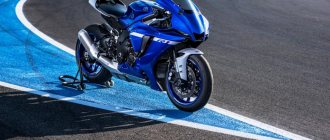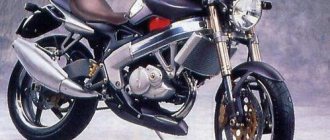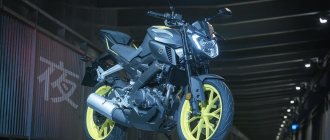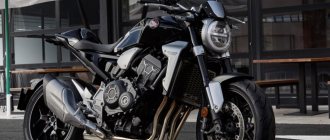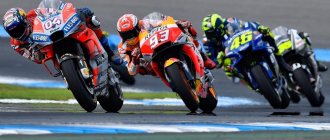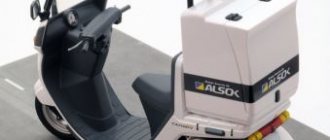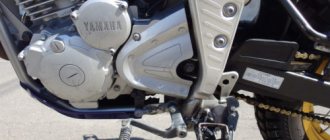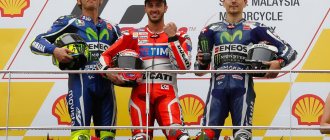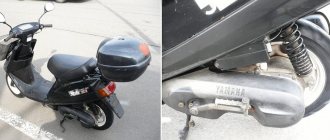The universe was born in one giant explosion. God (the laws of nature, cosmic superintelligence, little green men - cross out what is unnecessary) lit a huge spark plug, and in the cauldron called “The Universe” there was a big bang. A huge amount of cosmic crap, consisting of dust and hydrogen, scattered over many millions of light years, and it eventually stuck together into planets and stars. In a word, the “Big Bang” (“BB”) gave birth to everything that surrounds us, including ourselves. This is one of the theories of the creation of the universe. But the most amazing thing is that in racing technology, the “Big Bang” (just a little smaller) actually produced a colossal revolution, the fruits of which can be seen in MotoGP, BSB, and even in some production sportsbikes.
Despite its V-5 configuration, the engine barely vibrates
For a long time (1) engineers and mechanics have been faced with a problem. Everyone already knew how to obtain large absolute values of power, but making this power accessible turned out to be more difficult. The fact is that with an increase in power, the pilots faced an increasingly acute problem of slipping, especially when exiting corners, and increased tire wear. This was confirmed by telemetry data: the motorcycles easily slipped the rear wheels, which is why many riders simply did not open the gas fully, sometimes not even once during the race! However, not all motorcycles are equally susceptible to this problem. Vehicles with in-line “fours” slid the most, and those with V-tubes slipped less. For this reason, many companies in MotoGP have settled on the V-shape.
Ducati Desmosedici was famous for its high power and tendency to overheat
However, not everyone did this. The fact is that although the V-shape allowed the gas to be opened a little earlier, it also had significant drawbacks. Such engines are noticeably longer than the “in-line” ones, which led to the need to lengthen the base, which is why the motorcycle lost its agility in corners. The cost of V-twin engines is significantly higher than in-line engines - this is an important factor for the team’s budget. Finally, the cost of servicing V-twin engines is also higher. Apparently, these factors saved the life of in-line engines. But problems with character and, as a result, with slippage, remained. It was then, in the nineties, that the idea was born: is it possible to combine the advantages of “row” and “V” engines in one engine?
The classic rower has the same intervals between flashes
At the time, no one really understood why V-twin engines allowed drivers to open the throttle earlier and more when exiting corners. Later, telemetry data and calculations helped to understand why the power of V-twin engines is easier to dose. Let's try to simulate a typical racing situation - getting out of a slow hairpin on a liter sportbike with an inline four. First gear, ten thousand on the tachometer. The total gear ratio (primary gear + first gear of the gearbox + main chain drive) is approximately equal to ten, i.e. For every ten revolutions of the crankshaft, there is one revolution of the rear wheel. In a four-stroke engine, the duty cycle corresponds to 720 degrees, i.e. two revolutions of the crankshaft. This means that in ten revolutions of the crankshaft, five explosions will occur in one cylinder. Multiply by four cylinders and we get 20 explosions per revolution of the rear wheel.
The circumference of the rear wheel is approximately two meters. This means that for each explosion there are ten centimeters of the tire surface - exactly the length of the average contact patch. In the case of an engine with equal intervals between explosions (classic inline-four), it turns out that during slippage, each subsequent explosion occurs just when a new portion of rubber is preparing to replace the slipped contact patch, thus preventing the tire from regaining grip on the asphalt ! Obviously, as the turnover increases, this situation only gets worse.
This is how V-fours work
V-twin engines are a completely different matter. In the case of a V-4 engine with a 90-degree angle between the cylinders (for example, a Ducati Desmosedici), the number of explosions per revolution of the rear wheel will remain the same (20), but there will be two explosions per length of the first (relatively) contact patch. But during the subsequent contact patch there will be no explosions at all! During this lull, the rubber has a much greater chance of regaining reliable grip on the asphalt, which allows riders to be more generous with the gas when exiting corners. It was this double explosion that was called the “Big One”.
“Ryadnik” Yamaha M1 also works using “Big Bang” technology
For those who do not want to plunge into the jungle of BV technology, its essence is easier to understand by imagining the operation of ABS - an anti-lock braking system. To prevent blocking (read: slipping) of the wheels during vigorous braking, the braking force is applied in pulses, in the intervals between which the wheels have a chance to regain grip. “Big Bang” technology is the same ABS system, only in reverse, that is, it reduces slipping not during braking, but during acceleration. Drivers must balance engine power within a razor-thin range when exiting corners. If the power is less, the rider will lose time. If it is more, uncontrolled drift of the rear wheel may occur, which at best will lead to loss of time, and at worst – to a fall. Power from the engine is transmitted to the rear wheel not in a continuous stream, but in pulses. If the pulses are too frequent, they will prevent the tires from maintaining contact with the road, making the driver's task more difficult. But by spreading these impulses out so that there are gaps between them, the rear tire has more opportunity to regain reliable grip and makes it easier for the rider to maintain optimal power.
According to rumors, the Kawasaki ZX-RR was one of the last to switch to the “Big Bang”
What interval between “explosions” will be optimal from the point of view of the traction force of the rear tire with the road? This is the biggest secret of the BV technology. Until now, no one knows exactly what the angle is between explosions in a Yamaha M1 or Kawasaki ZX-RR. But what’s most interesting is that even in motorcycles with V-twin engines, according to rumors in the paddock, the angle between the explosions is not necessarily equal to the camber angle of the cylinders. Experts believe that in the case of the Honda RC211V, angle ranges such as 75.5-284.5 degrees and 104.5-331 degrees are likely between the “Big Bangs”. In the case of the Yamaha M1, angles such as 180-540, 105-255, 255-465, 90-270 and 270-450 degrees are called. The angle between the explosions within the pair forming the “BV” is most likely around ten degrees. However, this is all just guesswork for now.
Implementation of the “Big Bang” in an in-line “four”
Having understood the theory of the racing universe, let's find out how we can organize the “Big Bang” in accordance with the technical standards of MotoGP. The easiest way is to use V-twin engines. Honda, Suzuki and Ducati did this. But as we have already found out, this path is not without its drawbacks. The second way is to make the inline-four work like a V-shaped one. Yamaha and Kawasaki followed this path. In order to achieve the “BV” effect in an in-line engine, the designers had to radically modify their crankshafts, fortunately this is allowed by MotoGP technical standards.
Thanks to the “2+3” configuration, the RC211V frame was made quite narrow
The “row” crankshaft was practically turned into a V-shaped one (except that each connecting rod is still located on a separate journal, and not in pairs, as in the V-4, and there are not three, but five bearings), and installed in the old crankcase with in-line arrangement of cylinders. The resulting vibrations were damped by a balancer shaft. Such an engine is very easy to recognize by its characteristic sound: it does not howl like classic inline-fours, but grumbles almost like a V-4. Apparently for this sound in the paddocks they called him “Growler”.
Another racing series where “BV” is also used is the British Superbike. But in BSB everything is much more complicated, since in accordance with technical standards, modification of the crankshaft is not allowed. However, the Virgin Mobile team has found a way around this limitation in their Yamaha YZF-R1. In accordance with the same rules prohibiting “playing” with the crankshaft, changing the camshafts is allowed. This means that by changing the order of operation of the valves and reprogramming the ignition system accordingly, you can change the order of operation of the cylinders of a conventional inline four. If we discard duplicative or frankly useless options, then there are two ways to simulate “BV” in an engine with a conventional 180-degree crankshaft:
Boom-180-BoomBoom-180-Boom-180-Pause(180)
With this scheme, the internal loads in the engine are small, but the “BV” is less efficient
BoomBoom-180-BoomBoom-180-Pause(360)
Internal loads in the engine increase significantly, but the “BV” effect also intensifies
The first option creates less stress on the piston group and gears, but the “Big Bang” is less effective, and the rear wheel slips only slightly less than usual when accelerating out of corners. The second option, on the contrary, puts more load on the insides of the engine, but more effectively prevents slipping. Which of these two options the team used is still a secret. But, judging by the feedback from Sean Emmett, a pilot of the Virgin Mobile team, it has become easier to drive a superbike with an imitation “BV”, and thanks to this innovation, it was possible to literally find an average of about two seconds per lap out of thin air, and also significantly extend the life of the rear tire.
The V-5 engine fits perfectly into the diagonal frame
Strange as it may sound, the “Big Bang”, albeit partially, has found application in ordinary road motorcycles for quite a long time. Everyone who preferred V-twin engines to in-line engines automatically came closer to the BV technology, but still not knowing the scientific explanation for this effect, they simply rejoiced at the gentler nature of their motorcycles and could talk for a long time about the unique character of their engines. There were attempts to introduce something similar to “BV” into in-line engines. It is unknown whether this is a coincidence or not, but back in the nineties, Yamaha released two motorcycles with in-line engines in which the crankshaft angle was different from 180 degrees. TDM850 and TRX850. Now it is difficult to understand why it was necessary to introduce something like “BV” into an engine with a power of only 73 hp. Perhaps this was a test of the designers' pen, which in 2004 finally became the best motorcycle of the royal class.
V-shaped “five” Honda RC211V with a “big bang”
We motorcyclists live in very interesting times. According to experts, now is the “golden age” of the motorcycle. Technologies that only two or three years ago were available only to the best racers on the planet are now freely available. In pursuit of perfection, designers squeeze every last drop out of iron. And the “Big Bang” technology is the best confirmation of this, because it is, in fact, the result of a deep analysis of the beating “hearts” of modern motorcycles. Scientists and engineers have been able to decipher the fundamental rhythm of a two-wheeled machine. Where racing technology will go in two or three years, only God knows. And we just have to enjoy these fruits while we can.
(1) But still a little later than the moment when the Lord created motorcycle racing and saw that it was amazing how good it was.
Anton Barsukov, photo by the author. Great Britain, 2005
MotoGP: New Yamaha YZR-M1 (2018) in detail - photos and specifications
Yamaha Factory Racing has unveiled the technical specifications and new livery of the 2021 YZR-M1 factory prototype at the Movistar Yamaha MotoGP presentation in Madrid. Considering that the true 2021 model has not yet been born, it’s too early to talk about the bike: today, tomorrow and Friday the M1 is being tested in Sepang by factory test pilots. Yamaha Factory Racing Director Lin Jarvis was not present at the presentation in Spain precisely because he had already left for Malaysia, where he is in charge of preparations for the IRTA MotoGP tests: they, with the participation of prize pilots of the teams, will start there on Sunday, January 28.
MotoGP – Yamaha YZR-M1 (2018) Valentino Rossi
Interesting nuances catch your eye. As promised at the factory at the end of 2021, Yamaha Factory is back to work with the 2021 model motorcycle. And it was he who was shown at the presentation today! If you compare the 2021 and 2021 Rossi motorcycles, you can note that only minor details have changed.
MotoGP - Yamaha YZR-M1 (2018) - new Brembo brakes
Smoother plastic (fewer bends), a new version of Brembo M50GP calipers, 340 mm carbon wheels - right away. Otherwise, even the Akrapovic exhaust pads are the same design that were introduced two years ago. The changes that are hidden under the plastic are not yet visible. But they exist. Firstly, the new model has a 2-section gas tank (not available in January 2021) - one section is on top, the second is hidden under the pilot's seat. Secondly, the M1 now has a different engine. Yamaha has a new electrical supplier - Furukawa Group, and that's it.
MotoGP - Valentino Rossi and his Yamaha YZR-M1 (2018) The list of title sponsors has changed slightly: the Eurasian Bank logos have disappeared from the ceremonial liveries of the motorcycles and the “skin” of the riders. Movistar has rebranded, with the communications company's poisonous green "3D" logo replaced by a sleek white on both bikes and clothing. There is more of the classic “Yamasha” blue. And the wheels turned black.
MotoGP - Yamaha YZR-M1 (2018)
2021 YAMAHA YZR-M1 Technical Specifications:
Engine: 1000 cc. liquid cooled, in-line, 4-cylinder
Power: more than 240 hp (176 kW)
Control electronics: Magneti Marelli AGO 340 with two 32-bit PowerPC processors with a frequency of 264Mhz, a 1024-channel data logger manufactured by 2D Debus & Diebold with 8Gb of memory. The set of sensors ranges from 26 to 32, including an inertial platform (6 accelerometers and 6 gyroscopes).
Control software: Dorna Sports
Chassis: frame - aluminum Delta Box type with variable geometry (fork offset and tilt, engine height, chassis length); pendulum made from a single piece of aluminum
Suspension: Öhlins inverted fork with aluminum cups, Öhlins TTX36 shock absorber
Length x Width x Height: 2060 x 650 x 1150 mm.
Wheelbase: 1450 mm (+/- 40mm)
Brakes: Brebmo M50GP 4-piston - 2 carbon 340 mm discs in front; 2-piston caliper and 1 steel disc at the rear.
Wheels: 17″ MFR forged magnesium alloy
Tires: Michelin 17″ PowerSlick
Dry weight: 157 kg
MotoGP - Yamaha YZR-M1 (2018)
MotoGP - Yamaha YZR-M1 (2018) MotoGP - Yamaha YZR-M1 (2018) - parts MotoGP - Yamaha YZR-M1 (2018) MotoGP - Yamaha YZR-M1 (2018) Valentino Rossi #46
MotoGP 21 – Dedicated to motorcycle racing fans
Motorized sports are not limited to just auto racing. There are still a lot of fairly popular sports, and one of them is motorcycle racing. For fans of this type of racing, there are not many games on the modern gaming market. Perhaps the most famous studio that develops motorcycle racing games is Milestone Srl, which gave the world such series as RIDE, MXGP and MotoGP. The latter will be discussed today.
The real MotoGP series can rightfully be called the “queen of motorcycle racing”, as it is the most prestigious series in road racing on racing motorcycles and attracts a large community of fans to the screens. And since 2013, the Milestone Srl studio has been developing a series of games of the same name. This franchise can be compared to F1 from Codemasters, as a new version of this video game is released almost every year.
However, if in car simulators the level of realism can reach a fairly high level, then with motorcycle racing things are not so rosy. Driving a real racing motorcycle requires a different way than driving a car. In addition, the motorcycle has completely different controls than simple pedals and steering wheels, which are much easier to reproduce as gaming devices.
If there are any “game manipulators” for motorcycle racing, then they exist either as some kind of simulators from professional teams, or as some kind of hand-made crafts from various craftsmen. Therefore, so to speak, for mass production, the developers of the series have to focus more on the gamepad than on any other devices. I think it’s worth coming to terms with this, because motorcycle racing is a rather complex sport for which it is difficult to invent a manipulator for the gaming industry.
In this regard, it is difficult to talk about the physics used in such games. There will definitely be some conventions here, which will certainly be noticed by those who in real life have at least once driven a racing motorcycle on a special racing track. However, Milestone Srl, if we look ahead, managed to create a rather interesting product.
Rossi, Marquez, Lorenzo, Pedrosa, Dovizioso - who is it?
If you are familiar with the names above, then most likely you are already familiar with the world of motorcycle racing. The MotoGP Championship is one of the main motorcycle racing championships that takes place on various circuits around the world. Competitions are held in three classes at once - MotoGP, Moto2 and Moto3. Representatives of Moto3 compete on motorcycles with single-cylinder 250 cm³ four-stroke engines, and in this class there is an age limit - the rider must not be older than 28 years or 25 years for beginners.
Moto2 class riders compete on motorcycles with 600cc four-stroke engines. Representatives of the senior MotoGP class compete on the fastest motorcycles with four-stroke 1000 cm³ engines. Let me give you some more technical characteristics of these classes.
- Moto3 - about 55 bhp, maximum speed - up to 248 km/h
- Moto2 - about 140 bhp, maximum speed - up to 300 km/h
- MotoGP - about 260 bhp, maximum speed - up to 362 km/h
MotoGP 21, as you probably already understood, is the official game of the MotoGP championship. It is on this platform that entertaining eSports events are held as part of a real championship. In general, when I first started the game, I had a strong feeling that I was playing a copy of F1 from Codemasters - similar modes, a similar career with video inserts, pilot customization, team selection, car improvements, team management, and so on. Milestone Srl did not come up with anything new and followed in the footsteps of the studio, which was recently purchased by EA. Is it good or bad? Considering that there are practically no similar games on the market, this is probably a pretty sensible move.
What's the point?
At the beginning of your career, you will be offered to completely customize your pilot - choose his appearance, overalls, coloring and much more. You can change all this during the championship. In addition, in the customization settings, the style of piloting a racing motorcycle is specified - this is a fairly important parameter that marks the nature of your piloting. As a tip, try different ones, don't settle for the balanced one, which definitely won't make you fast on the track.
At the first stage, do not skimp and spend time on training. It’s even better if you try motorcycles in the “Time Attack” mode when you first start the game. You need to get used to the physics of controlling such equipment, which is several times different from a car. Also, don't try to go straight to MotoGP. The developers took a rather unconventional path and created physics that you need to get used to, which you need to study further in order to be fast, which can be a kind of challenge. Therefore, in career mode, try to conquer Moto3 first, and only then climb the career ladder to MotoGP.
If we get ahead of ourselves, the developers may scare away an inexperienced player with such physics. But on the other hand, when you spend time learning the basics of driving a racing motorcycle and drive a certain number of kilometers on the race track, you understand this zest, which makes MotoGP a good simcade.
So you've launched your career. First of all, you will be asked to choose a team, sponsors and staff. After this, you are introduced to the calendar, a development tree, which is distinguished by the availability of the development of certain elements for each class. Over the weekend, you will receive points for the development of certain components, and you will also have to manage the number of personnel involved in development. The time it takes to develop a particular improvement depends on the proper distribution of employees.
A typical weekend consists of several series of practice sessions, two qualifying sessions, a warm-up and the main race. Before the start of the stage, you can configure which sessions you want to participate in. If you are a beginner, then do not be lazy and spend time on training rides. But here you will face certain difficulties - for a fairly large number of training races you need to correctly distribute sets of tires, and you also need to leave certain sets for two qualifications, a warm-up and the main race.
In the development section, you can see the tasks that you face to get the coveted points for the development tree. It is with them that you can buy yourself this or that improvement. If you need to get into the settings of the motorcycle itself, then you can use an assistant who will ask you certain questions about driving the motorcycle and help you make proper adjustments to the suspension, gearbox, and so on.
During practice runs and the race you will need to monitor tire wear. In addition, according to MotoGP rules, you can put different sets of tires on your wheels, for example, a soft type on the front wheel, and a medium type on the rear wheel. When choosing tires, you also need to focus on the temperature on the track - read the tip that appears in the tire selection menu, it will help you decide on the choice of tires.
During the race, you also need to monitor your fuel consumption and switch fuel consumption modes - much like in F1 from Codemasters. Various control assistance systems are also available for motorcycles - TCS (traction control system), AW (anti wheelie), EBS (engine brake system), PWR (power mapping). They also need to be dealt with in practice runs, so, as I wrote above, never skip practice.
Also avoid collisions with other racers. While in motorsports there can be some light contact, in motorcycle racing even a slight push can end your gravel race. You should not aggressively attack your opponents, you should not aggressively defend yourself - any careless actions can lead to leaving the distance.
Graphics and visuals
With MotoGP 20, developers switched to the Unreal Engine, which is quite popular in the gaming industry. We created the popular simulator Assetto Corsa Competizione. However, I would not say that the graphics in MotoGP 21 are at their best. While the motorcycle models and overalls are quite detailed, the tracks and surroundings leave much to be desired.
When you're used to laser-scanned tracks, the drawn tracks in MotoGP seem very toy-like. From my point of view, Milestone Srl needs to correct this aspect. Yes, you need to invest in this, but it will add realism and pleasure to the game. In addition, the game is the official video game of the real championship and this feature can certainly make it stand out.
The physics of accidents is average, which the developers still have to work on. Pilots do not fall very naturally during a collision, and their somersaults sometimes resemble something supernatural. Visually, nothing falls off the motorcycles in fairly hard collisions, but still I want to see this kind of realism.
In my opinion, the menu design in last year’s part was a little better than in MotoGP 21. Developers, please make something more modern. Even the current UI design in iRacing looks better than the menu elements and controls in the game from Milestone Srl. And here you don’t need to do something superior, just make a convenient and modern menu with a modern minimalist design. This is enough for a game like this.
MotoGP has a pretty good photo mode. With its help you can get very beautiful screenshots, add a speed effect to them, adjust the focus and much more. Moreover, camera control is implemented quite conveniently, if you use a gamepad to control it - from the first launch it is clear where you need to press to get a high-quality picture. True, there is some misunderstanding in the operation of some modes, but I think this will go away with practice. Is a mode like this needed in racing games? Yes, definitely.
Bottom line
MotoGP 21 is a pretty good sim-cade, implemented under the auspices of the official MotoGP racing series. If you are a fan of motorcycle racing, then the game will suit your taste, however, first, understand the physics of driving a motorcycle and spend time on training. As for the visual part, from my point of view, it needs to be improved - add scanned tracks, improve the environment. Still, it’s much more pleasant to drive on exactly recreated tracks than on simply rendered racetracks. It would be nice to improve the damage system and the animation of riders when falling - it may be difficult, but watching supernatural somersaults is not very good in modern realities.
If you want to keep abreast of news, subscribe to our group on VKontakte, channel on Telegram and Instagram!
MotoGP - what is it anyway?
MotoGP is the motorcycle world championship - twenty races, visiting sixteen countries on five continents. All this is broadcast live on TV channels around the world. The best motorcyclists ride in three categories, differing in maximum engine power and many other features. The World Championship itself was established by the FIM - the International Motorcycle Federation - back in 1949 and continues continuously to this day. The oldest motorcycle racing series in the world takes place on Grand Prix weekend. The Royal class was originally called simply "500cc", of course due to the displacement of the engines.
Battle for victory between Marquez and DoviziosoWalka o zwycięstwo między Márquezem a Dovizioso© Gold & Goose / Red Bull Content Pool© Gold & Goose / Red Bull Content Pool
However, in 2002 the rules changed, ushering in the era of four-stroke motorcycles with a maximum displacement of 990 cc. See also a different name was introduced and the main class now races under the name MotoGP. In 2007, the rules were changed again, limiting power to 800 cc. See, and then - in 2012 - the introduction of "thousands". Since 1992, Dorna Sports has become the owner of the rights to the series, of course under the control of the FIM.
Failure of Rossi, Yamaha and Ducati
In the absence of Marquez, an unpleasant surprise was the lack of speed among the pilots of the factory Yamaha and Ducati - only one race won by Maverick Viñales on the account of Monster Energy Yamaha MotoGP and two victories for the Ducati Team, won by Andrea Dovizioso and Danilo Petrucci.
Not a single victory for Valentino Rossi, who was content with a single podium during the season, not a single victory for the Repsol Honda Team. With the latter, everything is clear - the loss of the team’s favorite immediately put an end to the team’s championship ambitions, since the departure of Jorge Lorenzo at the end of the 2019 season and the signing of a contract out of despair with Alex Marquez, a MotoGP debutant, clearly did not contribute to the fight for high positions.
It seems that the Yamaha pilots were not satisfied with the new motorcycle, the engine of which also turned out to be not the most reliable, which led to proceedings at the end of the season and the loss of points in the team competition. In the Ducati Team, traditionally the bike turned out to be not the easiest and friendliest for pilots, and the situation was further aggravated by the new Michelin tires, which were difficult to warm up, and the pilots themselves had to change their driving style, all to no avail. Plus, the contract issue remained unresolved for a long time, and in conditions of uncertainty in the future, and even more so after it became clear that neither Dovizioso nor Petrucci would remain in the team for the next season, it was difficult for the pilots to find motivation to develop the motorcycle.
Related news
MotoGP pilot Iannone, who appealed his doping ban, received an even greater punishment
The Doctor's failure can partly be explained by the same thing. Rossi became the only MotoGP pilot diagnosed with coronavirus, which forced Valentino to miss both races in Aragon, but even without this, the season became a failure for the titled Italian. Having won his 199th career podium in MotoGP, Rossi seemed to be under a spell - he could not achieve his 200th top-3 finish, much less his 90th victory in the top class.
But the 41-year-old driver does not intend to hang up his helmet - yes, the factory team, after 15 years of cooperation with Valentino, did not renew his contract, preferring the young talent Fabio Quartararo
, but Rossi was not left completely without a place. He went to the private Petronas Yamaha SRT to take the place of the French pilot - the “Doctor” was promised a motorcycle in factory specification and full support from the factory, so in the absence of gigantic pressure, the Italian may well present a pleasant surprise in 2021.
Examples of this can be found in the past season, where in the absence of a clear leader, whose total dominance demotivated everyone else, those who vegetated in secondary roles were able to express themselves.
Frightening accident in MotoGP: the legendary Rossi was almost hit by a bike at a speed of under 300
MotoGP is the most prestigious racing series in the world
Over the past sixty years of racing, MotoGP has appeared in almost every corner of the world, and if you look at the statistics, in 2021 there were more than 2.8 million fans on all tracks! The Spaniards, led by Marc Márquez, have dominated the Grand Prix circuit of late, with as many as four rounds taking place, but the top leaders are - or were - also competitors from Italy, the UK, Australia and the US. States.ConnectedEnd the confusion! We know the MotoGP lineups for the 2021 season! Read article
